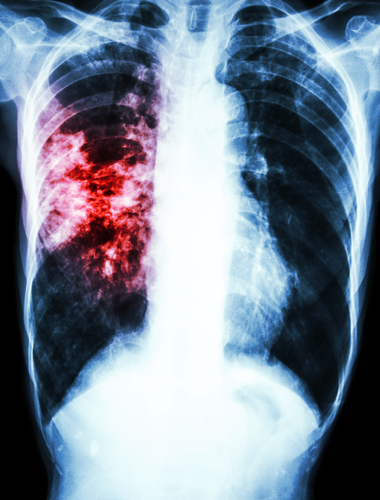Research Demonstrates Reversal Of Pulmonary Fibrosis With miRagen Therapeutics Synthetic microRNA-29 Mimic (promiR-29)

 New findings resulting from a research collaboration between miRagen Therapeutics Inc., a biopharmaceutical company developing innovative microRNA-based therapeutics, and Yale University scientists demonstrate that synthetic microRNA-29 Mimic promiR-29 reversed fibrosis in a mouse model of pulmonary fibrosis. These findings were published in the journal EMBO Molecular Medicine on September 19.
New findings resulting from a research collaboration between miRagen Therapeutics Inc., a biopharmaceutical company developing innovative microRNA-based therapeutics, and Yale University scientists demonstrate that synthetic microRNA-29 Mimic promiR-29 reversed fibrosis in a mouse model of pulmonary fibrosis. These findings were published in the journal EMBO Molecular Medicine on September 19.
The research paper, entitled “MicroRNA mimicry blocks pulmonary fibrosis,” (Article first published online: 19 SEP 2014 DOI: 10.15252/emmm.201303604) is coauthored by Rusty L Montgomery, Paul A Latimer, Christianna Stack, Christina M Dalby, and Kathryn Robinson of miRagen Therapeutics, Inc, Boulder, Colorado; Naftali Kaminski and Eva van Rooij of the Section of Pulmonary, Critical Care and Sleep Medicine, Yale School of Medicine, New Haven, Connecticut; and Guoying Yu of the Hubrecht Institute, KNAW and University Medical Center Utrecht, Utrecht, The Netherlands.
The coauthors note that over the last decade, great enthusiasm has developed in the scientific community regarding microRNA (miRNA) therapeutics. Part of this excitement, they observe, stems from the fact that a miRNA often regulates numerous related mRNAs. As such, modulation of a single miRNA allows for parallel regulation of multiple genes involved in a particular disease.
The researchers say that while many studies have demonstrated therapeutic efficacy using miRNA inhibitors, efforts to restore or increase the function of a miRNA have been lagging behind. However, the miR-29 family has gained a lot of attention for its clear function in tissue fibrosis, and this fibroblast-enriched miRNA family is downregulated in fibrotic diseases which induces a coordinate increase of many extracellular matrix genes.
In this study, they show that intravenous injection of synthetic RNA duplexes can increase miR-29 levels in vivo for several days. Moreover, therapeutic delivery of these miR-29 mimics during bleomycin-induced pulmonary fibrosis restores endogenous miR-29 function whereby decreasing collagen expression and blocking and reversing pulmonary fibrosis. THe researchers say their data support the feasibility of using miRNA mimics to therapeutically increase miRNAs and indicate miR-29 to be a potent therapeutic miRNA for treating pulmonary fibrosis.
[adrotate group=”3″]
The scientists conclude that their data derived from this research venture,provide great promise for use of miRNA mimics to therapeutically increase miRNA levels in vivo and indicate miR-29 to be a potent therapeutic miRNA for treating pulmonary fibrosis.
 The mimic when injected into the blood goes to the lung and it has a sustained effect. We are very impressed that it can reverse fibrosis not only prevent it says Naftali Kaminski M.D. , the Boehringer-Ingelheim Professor of Internal Medicine, Section Chief of Pulmonary, Critical Care and Sleep Medicine, at Yale School of Medicine, and a corresponding author of the study.
The mimic when injected into the blood goes to the lung and it has a sustained effect. We are very impressed that it can reverse fibrosis not only prevent it says Naftali Kaminski M.D. , the Boehringer-Ingelheim Professor of Internal Medicine, Section Chief of Pulmonary, Critical Care and Sleep Medicine, at Yale School of Medicine, and a corresponding author of the study.
Research in Dr Kaminski’s lab at Yale School of Medicine is currently focused on improving scientific understanding and treatment of chronic lung diseases such as Idiopathic Pulmonary Fibrosis (IPF), a chronic, mostly lethal and currently untreatable scarring lung disease and other chronic lung diseases such Chronic Obstructive Pulmonary Disease (COPD), severe asthma and sarcoidosis. His group applies cutting edge high throughput technologies that measure changes in the sequence, expression or regulation of all the genes in the human genome to identify the mechanisms, improve the diagnosis and develop new therapeutic targets.
While lung diseases have traditionally been defined by objective clinical characteristics, these characteristics usually do not predict outcome, response to therapy and morbidity and mortality. Dr. Kaminski says that to realize the promise of personalized medicine, the current diagnostic approaches to chronic lung diseases should be modified to include both information on the genetics, epigenetics and microbiome of the individual and the diseased organ as well dynamic molecular information that can more precisely define the etiology, stage, and the biological activity of the disease process.
Dr. Kaminski’s group pioneered the application of high throughput genome scale transcript profiling in advanced lung disease. Among his key discoveries are: The discovery that matrix metalloproteases such as MMP7 and MMP19 have significant active roles in determining the lung phenotype in patients with IPF, demonstrating that microRNAs, a family of small non-coding RNAs, are differentially expressed in IPF, and that some of them such as microRNA Let-7 and mir-154 are mechanistically involved in lung fibrosis, and the discovery that the outcome of patients with IPF can be predicted based on the expression of peripheral blood proteins and genes, a finding with practical implication because of the need for risk stratification and transplant prioritization.
Results from the collaborative research conducted by miRagen and Yale have led to the award of a Centers for Advanced Diagnostics and Experimental Therapeutics in Lung Diseases Stage II grant from the National Institutes of Health to further evaluate this potential therapeutic approach.
 “miRagen is committed to translating these pre-clinical findings into transformative therapies for patients with Idiopathic Pulmonary Fibrosis” says Dr. David Rodman Executive Vice President of Research and Development at miRagen Therapeutics Inc. “We are excited about the collaboration with Dr. Kaminski and by the potential for accelerated progression to human clinical trials afforded by the CADET II grant award.” Dr. Rodman leads miRagen’s research and development activities. Prior to joining miRagen, he was a Vice President of Clinical Development at Vertex Pharmaceuticals Incorporated. In that role, he reported directly to the Chief Scientific Officer and teams he led participated in the development of Vertex’s cystic fibrosis programs, which all received Breakthrough Therapy Designation from the U.S. FDA and delivered successful IND and CTA applications in the U.S., Europe and other countries.
“miRagen is committed to translating these pre-clinical findings into transformative therapies for patients with Idiopathic Pulmonary Fibrosis” says Dr. David Rodman Executive Vice President of Research and Development at miRagen Therapeutics Inc. “We are excited about the collaboration with Dr. Kaminski and by the potential for accelerated progression to human clinical trials afforded by the CADET II grant award.” Dr. Rodman leads miRagen’s research and development activities. Prior to joining miRagen, he was a Vice President of Clinical Development at Vertex Pharmaceuticals Incorporated. In that role, he reported directly to the Chief Scientific Officer and teams he led participated in the development of Vertex’s cystic fibrosis programs, which all received Breakthrough Therapy Designation from the U.S. FDA and delivered successful IND and CTA applications in the U.S., Europe and other countries.
microRNAs
MicroRNAs have emerged as an important class of small RNAs encoded in the genome acting as master regulators of gene expression. Recent studies have indicated that microRNAs appear to be associated with many disease processes. Because they are thought to be single molecular entities that dictate the expression of fundamental regulatory pathways microRNAs represent potential drug targets for controlling many biologic and disease processes.1
microRNA-29
The microRNA-29 family is a well-established regulator of extracellular matrix genes. The expression of the three family members is consistently down-regulated in a number of pathological fibrotic conditions including cardiac renal hepatic and pulmonary fibrosis as well as systemic sclerosis2345. Numerous studies in cell-culture and genetic replacement in rodents have also demonstrated the potential of miR-29 normalization to correct many drivers of pathological fibrosis.
miRagen Therapeutics, Inc. , is a biopharmaceutical company discovering and developing innovative microRNA (miRNA)-targeting therapies to improve human health, specifically in disease areas of high unmet medical need.
The company leverages in-house expertise in miRNA biology, oligonucleotide chemistry, and drug development to evaluate and advance best-in-class technologies and high-potential drug candidates for its own pipeline or in conjunction with strategic partners.
From its founding, miRagen has developed ongoing, collaborative relationships with academic institutions that give the company unique access to the most promising early-stage discoveries. This access to groundbreaking science provides a significant strategic advantage in the rapidly-developing field of miRNA-targeting therapeutics.
miRagen’s areas of research focus include cardiovascular disease, metabolic disease, and pathological fibrosis. In 2011, the company formed a strategic partnership with Servier, a privately-run, French research-based pharmaceutical company, to advance three miRNA-targeting drug candidates for the treatment of cardiovascular disease.
For more information, visit:
https://miragentherapeutics.com/
Sources:
miRagen Therapeutics
Kaminski lab at Yale School of Medicine
EMBO Molecular Medicine
Image Credits:
miRagen Therapeutics
Kaminski lab at Yale School of Medicine






